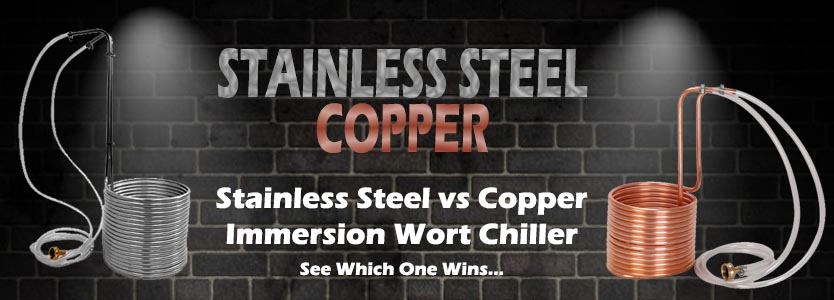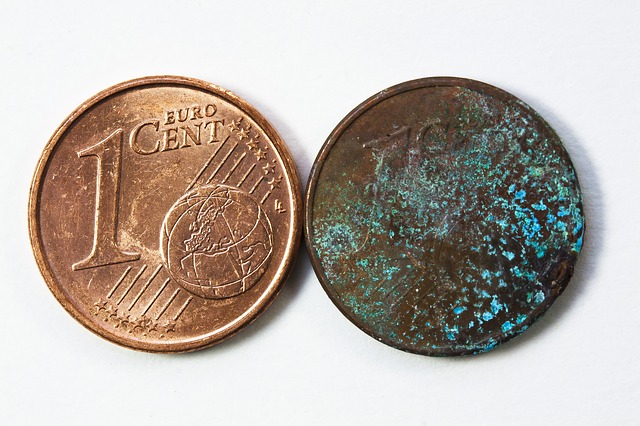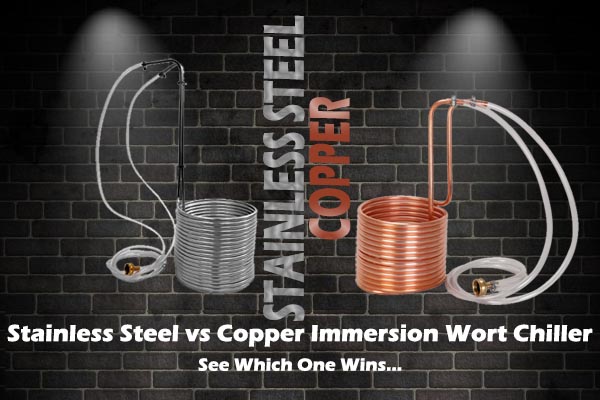One of the keys to brewing good beer at home is the ability to cool your wort fast. And the faster the better! So you might have looked at all of the wort chiller options out there and decided to go with an immersion wort chiller.
Now you run into the next decision, and that’s whether to go with a stainless steel or copper wort chiller. Like a boxing match, it’s going to be a heavy bout between a stainless steel vs copper wort chiller. Now let’s find out who’s going to win. But more importantly we’re going to find out why one wort chiller will win over the other.

Stainless Steel Vs Copper Wort Chiller – Which Is Better?
One of the advantages of using an immersion chiller is the lower risk of contamination versus other methods when used in an amateur/homebrewing environment.
So is it better to have a copper or stainless steel wort chiller?
There are more benefits to a copper immersion wort chiller than the stainless steel wort chiller. A copper wort chiller will cool your wort faster, and produce a better cold break. By cooling wort faster and producing a better cold break your hop profile will be locked in because the process halts the isomerization of alpha acids.
Basically, this effects the IBU (International Bitterness Unit) of the beer and how bitter it will be.
Now, even though we say a copper immersion wort chiller “wins” the battle between stainless steel and copper it doesn’t mean there’s not a place for a stainless steel wort chiller. Because stainless steel does actually have some advantages over copper.
I bet you thought it was going to be an easy fight when we said copper was better at the beginning, didn’t you! But it was actually a pretty close fight between our battle of a stainless steel vs copper wort chillers. So now let’s take a look at the pros and cons of each of these immersion wort chillers.
Copper Immersion Wort Chiller
Since we said copper “won” let’s look at the pros and cons of the copper wort chiller first.
The Pros
As we mentioned earlier, a copper immersion wort chiller will cool your wort faster which is what we should all want. The immersion chiller will hook up to a water supply and cold water will flow through the copper tubing. Heat from the wort will transfer through the copper piping and into the cooler water running through it, and this is what will bring the wort to room temperature quickly.
This is because copper has a better heat exchange rate than stainless steel. In this case, the heat exchange is made by conduction. The conductivity allows the walls of copper tubing to be relatively thick which helps the copper bend into shape without breaking.
The copper is also good for the yeast. Wort is mildly acidic and dissolves the small amounts of copper necessary for good yeast health. As the beer ferments, copper acts to reduce the concentration of hydrogen sulfide. Like humans, yeast requires trace amounts of copper for normal cellular functions.
Copper is well known to be resistant to corrosion which is really helpful when it comes to beverages that you’re going to be consuming. Copper reacts quickly to its environment and forms a film on the surface oxidation. You probably noticed this tarnish or patina before. Think of an old copper penny you might have seen. This patina only affects the appearance of the copper and does not actually damage the structural integrity of the copper.

Because of this the metal itself does not deteriorate. The surface oxidation adheres tightly to the surface, preventing exposure to further corrosion. Although some may not like the look, and it could be considered a con, we’ve gone into the tarnishing enough for you to understand it and we won’t discuss it below under the cons.
Copper is also easy to clean. This is great for homebrewers because we have enough cleaning to do from brew day. So who wants to spend more time cleaning their immersion wort chiller? Since the wort only touches the outside of a wort chiller it’s easy to tell if it’s clean or not. To clean a copper wort chiller just follow the steps below:
- Set the wort chiller in a cleaning solution like Powdered Brewery Wash.
- Rinse the immersion chiller with water.
- Set your wort chiller in a sanitizing solution. Star San will work great, and after a few minutes any residual wort that could cause bacteria to grow should be removed.
The Cons
The biggest con for a copper wort chiller has to do with the cost. Copper is a commodity and the cost of copper can fluctuate a lot. So naturally, the cost of a copper immersion wort chiller would go up and down with the price of copper. As of October 2020 the 5-year high was $3.11 and the 5-year low was $2.79 per pound. This kind of fluctuation would drastically impact the cost of your copper wort chiller and opens up the market to a stainless steel wort chiller.

Another disadvantage is that copper, as a material, isn’t as strong as stainless steel. This makes a copper wort chiller more susceptible to damage than stainless steel. So if you’re using it, or even while it’s in storage, something bangs into it you could damage the piping. This could lead to decreased performance, or worse yet, no performance at all if the damage is bad enough. But to damage the copper that bad would also take quite an impact! We just wanted to mention that it’s possible.
Now we get to cleaning. Overall, immersion wort chillers are easy to clean. But if a copper wort chiller isn’t properly cleaned the copper can develop a toxic oxide called Verdigris. Verdigris is the blue-green tarnish on that will appear on copper after time. You see this a lot on copper that’s left outside for a while. In this case, if the copper hasn’t been properly cleaned. This is what can ultimately lead to the deterioration of the copper and leads to a defective wort chiller.
Stainless Steel Immersion Wort Chiller
Now that we talked through the copper wort chiller let’s discuss the stainless steel wort chiller. Although stainless steel didn’t “win” the fight in stainless steel vs copper it didn’t exactly get knocked out, either. Now let’s go into the pros and cons of a stainless steel wort chiller and find out why it was a close match.
The Pros
The first positive for a stainless steel wort chiller is that stainless steel is great when it comes to resistance of corrosion. The corrosion resistance is because of a very thin oxide layer on the steel’s surface. This layer protects the steel from corrosion unless something damages the protective coating where rust can begin to form. This helps make a stainless steel wort chiller easier to clean and maintain. Cleaning a stainless steel wort chiller would follow the same exact process as the copper wort chiller we mentioned earlier.
- Set the wort chiller in a cleaning solution like Powdered Brewery Wash.
- Rinse the immersion chiller with water.
- Set your wort chiller in a sanitizing solution. Star San will work great, and after a few minutes any residual wort that could cause bacteria to grow should be removed.
Then we have the durability factor. Stainless steel is strong! This means that a stainless steel wort chiller is not as susceptible to damage as a copper wort chiller. Since stainless steel is stronger than copper the walls of the tubing can be made thinner. It’s a compound metal and made in different grades of steel. So being able to keep the walls thin helps to negate stainless steels poor heat conductivity.
The cost of stainless steel doesn’t have price fluctuations like the cost of copper does. This means that the cost of a stainless steel wort chiller will more likely the same in a month from now as it is today. That’s not the case with a copper wort chiller. So if you need a wort chiller and the price of copper happens to be high than you might lean more towards a stainless steel wort chiller.
The Cons
Well, we may as well talk about the thermal conductivity of stainless steel first. Because the conductivity isn’t as good as copper, a stainless steel wort chiller will cool your wort slower than a copper wort chiller would. Again, this isn’t to say that stainless steel is bad. It just won’t cool as fast.
When we talked about the pros of stainless steel we mentioned that it’s a strong compound. And that is a positive. But in some circumstances it could also be a negative. Sometimes you want to be able to bend the steel or manipulate it in some way to either perform better or have more submersion in the wort. Well, you can’t really make those simple adjustments with a stainless steel wort chiller.
We also mentioned earlier that copper is good for yeast as it oxidizes and gets its patina. Since stainless steel doesn’t have this same reaction you won’t get those benefits to yeast as you’re cooling your wort.
Final Thoughts On The Stainless Steel Vs Copper Wort Chiller Battle
We’ve reviewed the pros and cons and the facts are in. It was a really close battle for the title in the stainless steel vs copper wort chiller battle. But our opinion is that copper does edge out a stainless steel wort chiller. It comes down to copper being a little more efficient than stainless steel.
Copper was the traditional brewing material for brewing beer well before stainless steel was even invented. So if you’re a traditionalist this would also give the copper wort chiller an edge. But really, an immersion wort chiller is highly effective in cooling wort and both wort chillers are very good options for brewing.

